Although power amps and line stages are the most numerous in the Pass Labs roster, it also features three integrated machines. Pass Labs INT-25 released in 2019 opens this group and was sent my way just recently.
Introduction
Audio reviewers such as myself often have to be patient as costly loaners don’t grow on trees. This report’s hero doesn’t either and it took a while for it to get to my place. Its makers’ policy puts customers on the pedestal thus everyone else interested simply has to wait, which is what Srajan and me did. Interestingly, Pass Labs assignments naturally became our conjoined efforts. The man himself opens such a report at 6moons.com, then I get a loaner first to do necessary photos whilst it’s fresh and shiny. Next my bit is published at Srajan’s and soon a product is dispatched from my crib to his in Ireland. He then reveals his own findings and writes final words. To readers this approach translates to two independent takes by two reviewers in their two very different rooms, but based on the same exact main course. If you’re interested in seeing how this cooperation plays out in practice, please take a look here and here. 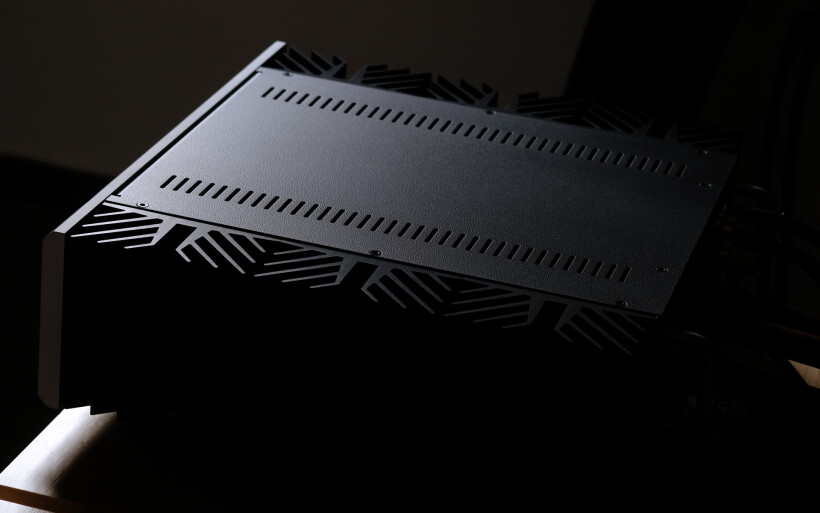 Thus far Pass Labs hardware I was fortunate to get my hands on wasn’t related to this operation’s core business. The XP-12 preamplifier and HPA-1 headfi deck aren’t big bold amps after all. Today’s assignment thus introduced the rare opportunity for me to get familiar with Pass Labs’ main component type in form of its INT-25 integrated amplifier. Upon receiving a mail in late July about it ready to be shipped, I gladly reported my own readiness. Good things come to those who wait, or so they say.
Thus far Pass Labs hardware I was fortunate to get my hands on wasn’t related to this operation’s core business. The XP-12 preamplifier and HPA-1 headfi deck aren’t big bold amps after all. Today’s assignment thus introduced the rare opportunity for me to get familiar with Pass Labs’ main component type in form of its INT-25 integrated amplifier. Upon receiving a mail in late July about it ready to be shipped, I gladly reported my own readiness. Good things come to those who wait, or so they say.
Build
Pass Labs INT-25 arrived dressed in an externally reinforced double cardboard. The key component wrapped in thick foil bag was found in-between two foam inserts. Sundry accessories included a manual, QC leaflet and handy quality aluminium RC. This remote was exactly the same as found in Pass Labs XP-12 preamplifier. Pass Labs INT-25 measures (W x H x D) 43.2 x 45.5 x 15.2cm and weighs 23.2kg, which turns it into a regularly shaped and sized amp though heavy. Although manageable single-handedly, one can easily tell it’s not a toy. Even the most compact and affordable products by the same audio house are anything but. Upon informing my contact Desmond about the INT-25 being my first big Pass, most likely amused he replied that it’s the smallest of its kind they make. After comparing my loaner to its higher tiered far beefier kin, I understood what was so funny. Its output power into 8/4/2Ω loads is 25/50/100wpc, gain is 26dB, THD at full blast is 0.1% (@8Ω, 1 KHz). Then there’s noise lesser than 150μV, a slew rate of 100 V/μS, 10A of peak current and 48kΩ/0.016Ω input/output impedance respectively. Power consumption is 200 watts.
Pass Labs INT-25 measures (W x H x D) 43.2 x 45.5 x 15.2cm and weighs 23.2kg, which turns it into a regularly shaped and sized amp though heavy. Although manageable single-handedly, one can easily tell it’s not a toy. Even the most compact and affordable products by the same audio house are anything but. Upon informing my contact Desmond about the INT-25 being my first big Pass, most likely amused he replied that it’s the smallest of its kind they make. After comparing my loaner to its higher tiered far beefier kin, I understood what was so funny. Its output power into 8/4/2Ω loads is 25/50/100wpc, gain is 26dB, THD at full blast is 0.1% (@8Ω, 1 KHz). Then there’s noise lesser than 150μV, a slew rate of 100 V/μS, 10A of peak current and 48kΩ/0.016Ω input/output impedance respectively. Power consumption is 200 watts. At the manufacturer’s site Pass Labs INT-25 is filed under the integrated tab, just a cut below its INT-60 model. It combines its makers’ entry-level XA25 stereo power amp with the latter’s simplified preamp stage. As a proper purist affair, today’s doesn’t feature anything that’s not absolutely critical. No DAC, network or phono boards, fancy footers, shiny front panels, large displays or any alternate finishes. What’s provided instead are stout radiators, robust visually austere enclosure and deep class A bias thus also heat that creates spacing and cooling demands. If you’re now wondering why to bother with all these bold measures, the INT-25 needs them to act accordingly.
At the manufacturer’s site Pass Labs INT-25 is filed under the integrated tab, just a cut below its INT-60 model. It combines its makers’ entry-level XA25 stereo power amp with the latter’s simplified preamp stage. As a proper purist affair, today’s doesn’t feature anything that’s not absolutely critical. No DAC, network or phono boards, fancy footers, shiny front panels, large displays or any alternate finishes. What’s provided instead are stout radiators, robust visually austere enclosure and deep class A bias thus also heat that creates spacing and cooling demands. If you’re now wondering why to bother with all these bold measures, the INT-25 needs them to act accordingly.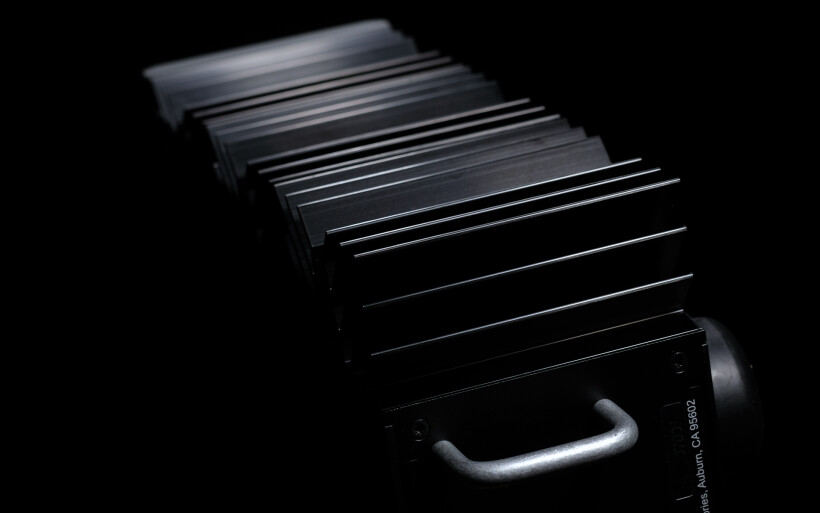 Pass Labs INT-25’s thick brushed-aluminium forehead features only mandatory stuff. Its small OLED displays only volume level (63 x 1dB steps) and can go dim via RC. A shallow recession just below houses five buttons in total (power on/off, three input selectors and mute) plus black IR window. An endlessly rotating substantial volume knob a bit further to the right sports mild friction, as if a thin felt insert was put in-between it and front panel. In effect it operates very pleasantly and stops quickly if rapidly turned. Large pointy heat sinks attached to the INT-25’s cheeks up the ante on visual seriousness though efficient heat dissipation is their primary role, further supported by two perforated rows at its bonnet. The product sits on four oversized rubber pucks and its rear features two solid handles, three gold-plated RCA inputs, quality Furutech FT-807 binding posts and fused IEC inlet.
Pass Labs INT-25’s thick brushed-aluminium forehead features only mandatory stuff. Its small OLED displays only volume level (63 x 1dB steps) and can go dim via RC. A shallow recession just below houses five buttons in total (power on/off, three input selectors and mute) plus black IR window. An endlessly rotating substantial volume knob a bit further to the right sports mild friction, as if a thin felt insert was put in-between it and front panel. In effect it operates very pleasantly and stops quickly if rapidly turned. Large pointy heat sinks attached to the INT-25’s cheeks up the ante on visual seriousness though efficient heat dissipation is their primary role, further supported by two perforated rows at its bonnet. The product sits on four oversized rubber pucks and its rear features two solid handles, three gold-plated RCA inputs, quality Furutech FT-807 binding posts and fused IEC inlet.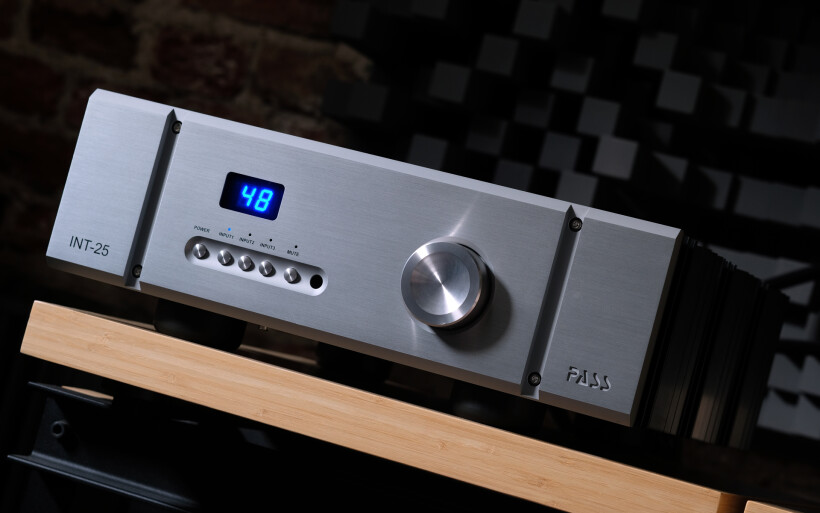 Just as Pass Labs XA25 stereo amp, the INT-25 also is a single-ended design with its output stage based on two 700-watt/40A Ixys HiPerFET transistors per channel for push-pull class-A work. Just two these devices replace what normally would look like a series of multiple smaller units. Today’s has its all stages undegenerated, which means that its Fets are free from ballast resistors to land lowest possible distortion and output impedance. No degeneration also results in higher efficiency and deeper class A bias into reactive and low impedance loads. A resistor ladder inside a chip handles volume attenuation, whereas a microprocessor-controlled optical shaft encoder connected to a knob on the product’s front is the UI.
Just as Pass Labs XA25 stereo amp, the INT-25 also is a single-ended design with its output stage based on two 700-watt/40A Ixys HiPerFET transistors per channel for push-pull class-A work. Just two these devices replace what normally would look like a series of multiple smaller units. Today’s has its all stages undegenerated, which means that its Fets are free from ballast resistors to land lowest possible distortion and output impedance. No degeneration also results in higher efficiency and deeper class A bias into reactive and low impedance loads. A resistor ladder inside a chip handles volume attenuation, whereas a microprocessor-controlled optical shaft encoder connected to a knob on the product’s front is the UI.
Sound
My fidata HFAS1-S10U handled storage/transport, then LampizatOr Pacific DAC (KR Audio T-100/Living Voice 300B + KR Audio 5U4G Ltd. Ed.) took over to pass the signal either to the INT-25, a Bakoon AMP-13R or the Thöress DFP/AGD Productions Audion combo. A Boenicke Audio S3 speaker cable connected either to sound|kaos Vox 3af or my own Boenicke Audio W11SE+. All hardware was powered by LessLoss C-MARC cords from a GigaWatt PC-3 SE EVO+ power conditioner fronted by its own LC-3 EVO cable. Interconnects used were Boenicke Audio IC3 CG and Audiomica Laboratory Erys Excellence where needed. The USB chain included the full iFi audio stack; a micro iUSB3.0, nano iGalvanic3.0, three Mercury3.0 USB cables in-between plus one 9V iPower. One set of LessLoss Firewall for Loudspeakers modules complimented all speakers in this review, and Fidelizer EtherStream was in-between my Linksys WRT160N router and fidata server. To properly review the Pass, a load tailored for its specs was needed, but some two weeks ago I had none. The product closest in my schedule to fit the profile was sound|kaos Vox 3afw. Upon asking nicely, Martin Gateley kindly sent my pair far sooner than planned. His compact monitors boast 92dB efficiency and Srajan already had found them to be ideal with Bakoon’s petite 25wpc AMP-13R. The same load should work fine with this report’s Pass of similarly rated power output. These two integrated decks squared up whereas the Vox 3af was the judge.
To properly review the Pass, a load tailored for its specs was needed, but some two weeks ago I had none. The product closest in my schedule to fit the profile was sound|kaos Vox 3afw. Upon asking nicely, Martin Gateley kindly sent my pair far sooner than planned. His compact monitors boast 92dB efficiency and Srajan already had found them to be ideal with Bakoon’s petite 25wpc AMP-13R. The same load should work fine with this report’s Pass of similarly rated power output. These two integrated decks squared up whereas the Vox 3af was the judge.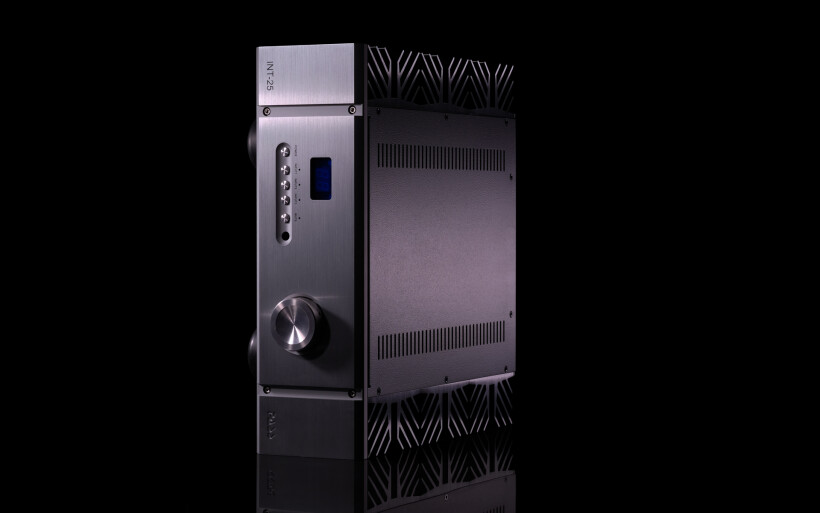 My previous Pass Labs encounters include their HPA-1 headfi amp, XP-12 linestage and FirstWatt F7 stereo power amp. This list is not long by any stretch and the INT-25 is in fact my first big Pass. Just so, each known to me device by this audio house shared the same sonic elegance. Think freedom from extreme bias towards chunk, zing or any other excess; ease, finely applied textural generosity, vividness, admirable expressiveness, overall sophistication and lack of shout, grit and harshness of any kind. Executed this tastefully and mature, the density of highly organic approach typical for class A drive can unlock large open landscapes which breathe and are free from any stuffiness. Images reveal naturally from within, instead of being spot-lit by extra treble. The ability to do all this borderline casual is the result of thorough engineering, silent circuitry and in general next-level play. Everything listed here is exactly what Pass Labs hardware known to me had stood for and projected forward into today’s assignment.
My previous Pass Labs encounters include their HPA-1 headfi amp, XP-12 linestage and FirstWatt F7 stereo power amp. This list is not long by any stretch and the INT-25 is in fact my first big Pass. Just so, each known to me device by this audio house shared the same sonic elegance. Think freedom from extreme bias towards chunk, zing or any other excess; ease, finely applied textural generosity, vividness, admirable expressiveness, overall sophistication and lack of shout, grit and harshness of any kind. Executed this tastefully and mature, the density of highly organic approach typical for class A drive can unlock large open landscapes which breathe and are free from any stuffiness. Images reveal naturally from within, instead of being spot-lit by extra treble. The ability to do all this borderline casual is the result of thorough engineering, silent circuitry and in general next-level play. Everything listed here is exactly what Pass Labs hardware known to me had stood for and projected forward into today’s assignment.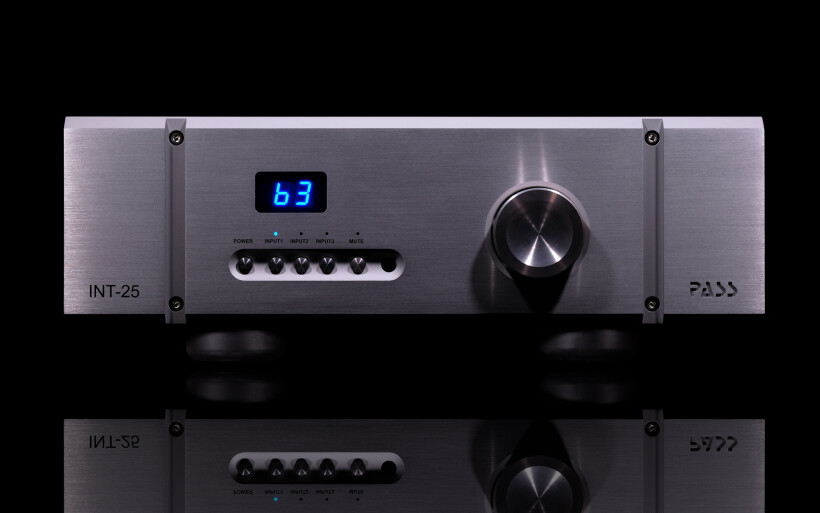 It’s very tempting to preview sound|kaos Vox 3afw alone, but that’s a separate story to tell. Srajan already covered this product extensively already. For now suffice it to say that it sounded remarkably well with the INT-25. The impression of a compact monitor on the job was absent from the get-go. Speaking of imaging, Vox 3afw fixed to its bronze stands evaporated from my room to leave admirably huge wall of quicksilvery open sound. Its lowest end was of rather tectonic reach thus more felt than heard. Overall bass presentation was clearly aspirated to hit hard down low yet remain perfectly composed higher up to avoid being overblown. Not for a second. The entire low register was very elastic, snappy and texturally loaded to suggest that tubes and open baffles had to be a part of it, except they weren’t.
It’s very tempting to preview sound|kaos Vox 3afw alone, but that’s a separate story to tell. Srajan already covered this product extensively already. For now suffice it to say that it sounded remarkably well with the INT-25. The impression of a compact monitor on the job was absent from the get-go. Speaking of imaging, Vox 3afw fixed to its bronze stands evaporated from my room to leave admirably huge wall of quicksilvery open sound. Its lowest end was of rather tectonic reach thus more felt than heard. Overall bass presentation was clearly aspirated to hit hard down low yet remain perfectly composed higher up to avoid being overblown. Not for a second. The entire low register was very elastic, snappy and texturally loaded to suggest that tubes and open baffles had to be a part of it, except they weren’t. Audible warmth often associates with elevated textural richness and round edges, but also mild veil and limited treble energy. However, this description doesn’t quite fit the sensation the INT-25 and Vox 3af left me with. Their conjoined effort was too open and easygoing to call warm. Increased tonal temperatures and carefully applied roundness played the part to a degree, but the more I became familiar with the Vox/Pass sound, the more it struck me as earthy. Speaking in DAC terms, it’d be a R-2R ladder type not a Burr-Brown or Sabre chip. A chocolaty tissue on voices and instruments is on an amp’s shoulders when in deep class A bias. Naturally neither the Vox 3afw nor INT-25 alone was responsible for this flavor. But more importantly, it easily presented everything as very alive and liquid in its form. Anything stale, overly dark, syrupy and bloated wasn’t there, quite the contrary in fact. The general impression was agile, fresh and expressive.
Audible warmth often associates with elevated textural richness and round edges, but also mild veil and limited treble energy. However, this description doesn’t quite fit the sensation the INT-25 and Vox 3af left me with. Their conjoined effort was too open and easygoing to call warm. Increased tonal temperatures and carefully applied roundness played the part to a degree, but the more I became familiar with the Vox/Pass sound, the more it struck me as earthy. Speaking in DAC terms, it’d be a R-2R ladder type not a Burr-Brown or Sabre chip. A chocolaty tissue on voices and instruments is on an amp’s shoulders when in deep class A bias. Naturally neither the Vox 3afw nor INT-25 alone was responsible for this flavor. But more importantly, it easily presented everything as very alive and liquid in its form. Anything stale, overly dark, syrupy and bloated wasn’t there, quite the contrary in fact. The general impression was agile, fresh and expressive.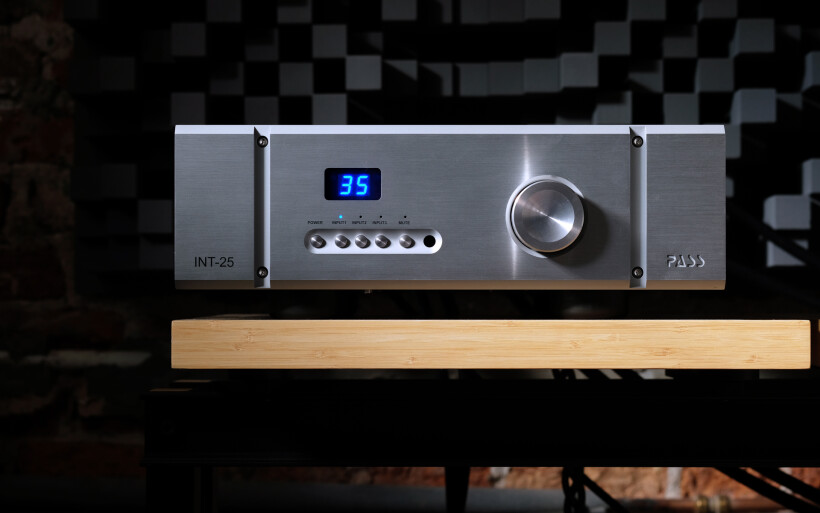 The Vox 3afw is capable of fabulously isolated truly intimate voices. That sort of artful articulation and sexiness is normally reserved for quality full-range drivers, but on this count the Swiss pull very similar stunts. Here it’s critical to say that the INT-25 showcased that particularly unique expressiveness with ease regardless of its naturally gravitational disposition. Sensual female lips nearly touching a microphone weren’t lost in translation. The Vox could flaunt its key virtues and all remaining traits freely, and clearly was very happy with the Pass. At this point I had a pretty good understanding of what this amp brought to the table, which marked the Bakoon o’clock.
The Vox 3afw is capable of fabulously isolated truly intimate voices. That sort of artful articulation and sexiness is normally reserved for quality full-range drivers, but on this count the Swiss pull very similar stunts. Here it’s critical to say that the INT-25 showcased that particularly unique expressiveness with ease regardless of its naturally gravitational disposition. Sensual female lips nearly touching a microphone weren’t lost in translation. The Vox could flaunt its key virtues and all remaining traits freely, and clearly was very happy with the Pass. At this point I had a pretty good understanding of what this amp brought to the table, which marked the Bakoon o’clock.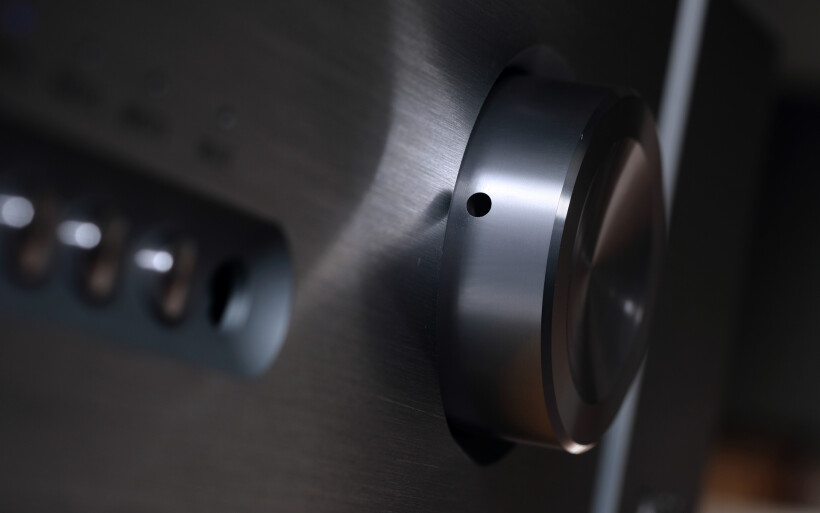 The AMP-13R and Vox share several qualities like lucidity, openness, magnifying prowess, grand agility, effortlessness, and in general happily lit-up profile. In a sense it would be fair to assume that their match wouldn’t be too synergistic. To keep overall balance in check, we inject hardware measures opposite to results already had. We usually marry i.e. fuzzy amps with piercing speakers and vice versa, chunky setups we treat with leaner quicker cables etc. Not today. The Vox/Bakoon combo doesn’t know what ‘usual’ is and that’s very clear. Secondly, hardware from a performance tier this high is subject to different rules. It features no obviously sub-par aspects in dire need of addressing. Top specimens cover all foundational bases and that’s what their substantial price should reflect. Since there’s nothing to fix, one can focus on mixing such products exclusively to tailor the sound to one’s liking. The Bakoon, Pass and Vox at all unlocked this option without fail.
The AMP-13R and Vox share several qualities like lucidity, openness, magnifying prowess, grand agility, effortlessness, and in general happily lit-up profile. In a sense it would be fair to assume that their match wouldn’t be too synergistic. To keep overall balance in check, we inject hardware measures opposite to results already had. We usually marry i.e. fuzzy amps with piercing speakers and vice versa, chunky setups we treat with leaner quicker cables etc. Not today. The Vox/Bakoon combo doesn’t know what ‘usual’ is and that’s very clear. Secondly, hardware from a performance tier this high is subject to different rules. It features no obviously sub-par aspects in dire need of addressing. Top specimens cover all foundational bases and that’s what their substantial price should reflect. Since there’s nothing to fix, one can focus on mixing such products exclusively to tailor the sound to one’s liking. The Bakoon, Pass and Vox at all unlocked this option without fail.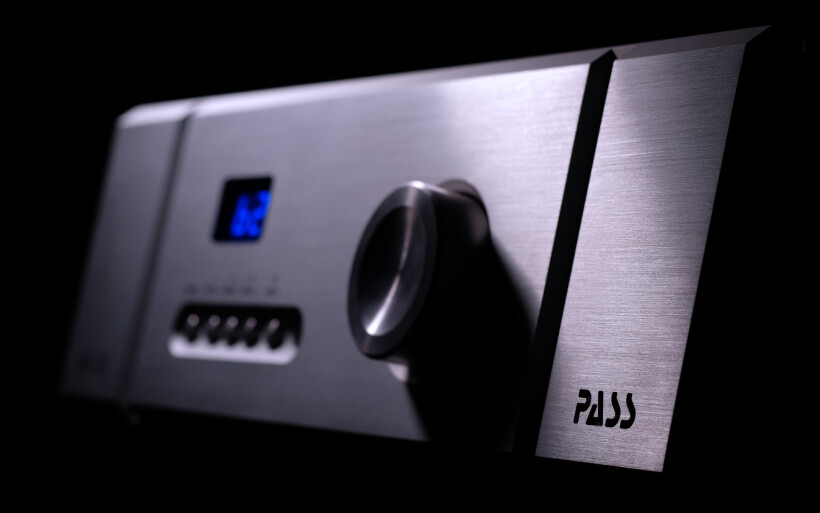 On overall sonic pedigree it didn’t really matter whether the Vox 3af was fronted by the Bakoon or Pass. Swaps caught no culprit. On counts such as spatial might, fluency, tissue, downstairs completeness, midrange charm, treble extension or sheer satisfaction, there were no bad choices, only significant very predictable alternates. The AMP-13R was the more snappy, lit up, sunnier, outlined and here. The Pass was darker, mellower, more composed, dense, round and there. The Bakoon accelerated harder, injected more oxygenation into space and more explicitly sculpted voices. The INT-25 presented as calmer, thicker, more romantic and distant. But with the former I had no craves for more oomph or body whilst the latter was sufficiently illuminated on top and responsive to not strike me as slow or hooded in comparison. Just as a top integrated should, each this report’s contestant avoided extremes. Two different voicings were equally coherent, complete and fit the Vox 3afw with utmost synergistic care.
On overall sonic pedigree it didn’t really matter whether the Vox 3af was fronted by the Bakoon or Pass. Swaps caught no culprit. On counts such as spatial might, fluency, tissue, downstairs completeness, midrange charm, treble extension or sheer satisfaction, there were no bad choices, only significant very predictable alternates. The AMP-13R was the more snappy, lit up, sunnier, outlined and here. The Pass was darker, mellower, more composed, dense, round and there. The Bakoon accelerated harder, injected more oxygenation into space and more explicitly sculpted voices. The INT-25 presented as calmer, thicker, more romantic and distant. But with the former I had no craves for more oomph or body whilst the latter was sufficiently illuminated on top and responsive to not strike me as slow or hooded in comparison. Just as a top integrated should, each this report’s contestant avoided extremes. Two different voicings were equally coherent, complete and fit the Vox 3afw with utmost synergistic care.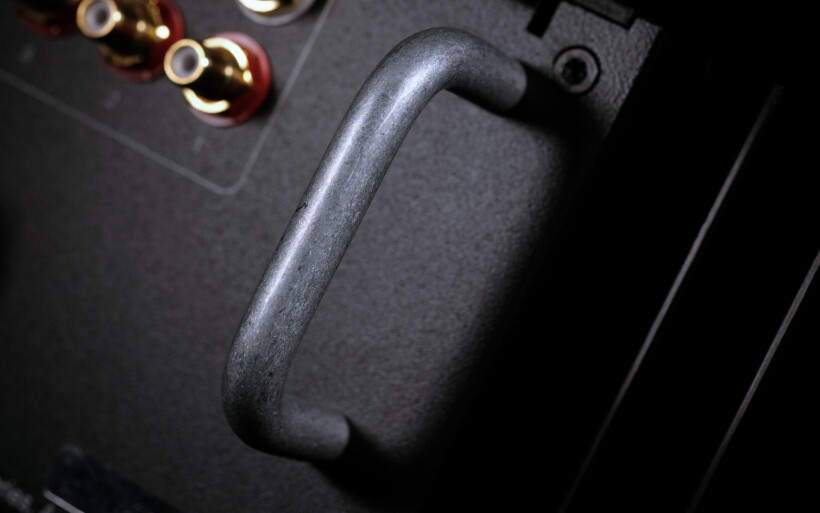 As long as it sees a copasetic load, the Bakoon fires off bass transients rapid, a spot on round and loaded with generous pigment to result in grand on-stage elasticity. This careful blend expands dynamic contrast, maintains moisture and turns into engaging lifelike act that get my foot tapping. Although softer and warmer, the inherently calm and meticulous Pass also was capable of this palpable action. When needed, it easily unlocked torque reserve to land mighty downstairs slams with no apology, as if it knew well how and when to stiffen its suspension and engage turbo to effectively go faster. Amps voiced like today’s are rev-happy audience and the INT-25/Vox 3afw fit that profile to perfection. The only difference is that the Pass by choice highlighted other traits of these speakers, whereas its elastic potential kept dullness, bloat and textural lifelessness at bay nonetheless. I’m convinced that many would’ve been very much surprised had they witnessed how dynamically gifted this machine was at my place, and how easily it shifted gears accordingly to the music on the menu. The ability to remain rich, mature and serene on the surface yet always ready to scale up big and snappy emerged as one of its greatest virtues.
As long as it sees a copasetic load, the Bakoon fires off bass transients rapid, a spot on round and loaded with generous pigment to result in grand on-stage elasticity. This careful blend expands dynamic contrast, maintains moisture and turns into engaging lifelike act that get my foot tapping. Although softer and warmer, the inherently calm and meticulous Pass also was capable of this palpable action. When needed, it easily unlocked torque reserve to land mighty downstairs slams with no apology, as if it knew well how and when to stiffen its suspension and engage turbo to effectively go faster. Amps voiced like today’s are rev-happy audience and the INT-25/Vox 3afw fit that profile to perfection. The only difference is that the Pass by choice highlighted other traits of these speakers, whereas its elastic potential kept dullness, bloat and textural lifelessness at bay nonetheless. I’m convinced that many would’ve been very much surprised had they witnessed how dynamically gifted this machine was at my place, and how easily it shifted gears accordingly to the music on the menu. The ability to remain rich, mature and serene on the surface yet always ready to scale up big and snappy emerged as one of its greatest virtues.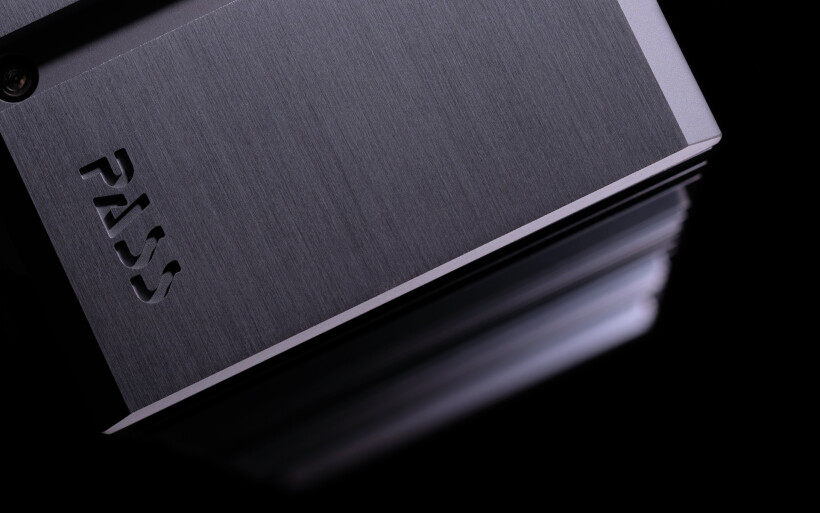 To reverse the above order, it’s fair to wonder whether a fundamentally quick lucid integrated amp would keep up with the Pass on tonal complexity, expressiveness, pristine backdrop and musical dosage. I knew no machine in the same price bracket that would meet all of its criteria. From what I’d heard, the Thöress F2A11 has far lower power, Audio Reveal Second favors more torque and less richness and the SPEC RSA-M99 may not have hit this hard if my memory serves me well.
To reverse the above order, it’s fair to wonder whether a fundamentally quick lucid integrated amp would keep up with the Pass on tonal complexity, expressiveness, pristine backdrop and musical dosage. I knew no machine in the same price bracket that would meet all of its criteria. From what I’d heard, the Thöress F2A11 has far lower power, Audio Reveal Second favors more torque and less richness and the SPEC RSA-M99 may not have hit this hard if my memory serves me well.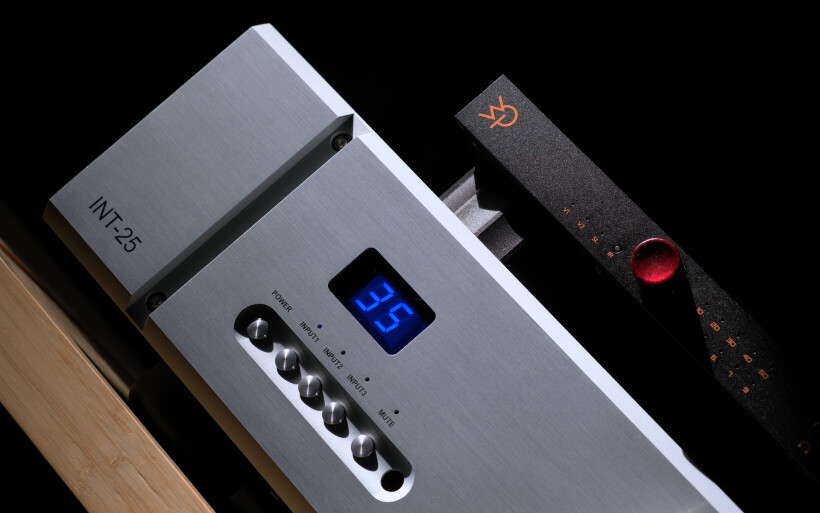 Moving on, Boenicke W11SE+ speakers were used to assess the INT-25’s driving potency. Here’s where the gap between this integrated and Bakoon widened. Although both share similar power rating on paper, the AMP-13R is only okay into this load and not spectacular versus its pairing with the Vox 3afw by any stretch. The key misses are lack of effortlessness and fill above 70dB of SPL where the petite Bakoon simply runs out of gas. During nocturnal sessions this would suffice. Alas, that’s not my audio habit so no dice. The Pass wrote a different far fiercer bolder story. It didn’t lack intestinal content at all. Elasticity during dynamically challenging passages at stout levels was delivered in large part. The sensation of ease, pleasant tactility and air propagated in just the right way to image large and free from veil was there. The Boenicke woofers were fully controlled and the speaker’s inherently hi-res organic character preserved. In short, the Pass did its thing on a somewhat lesser scale than it had with the far easier with the Vox 3afw load.
Moving on, Boenicke W11SE+ speakers were used to assess the INT-25’s driving potency. Here’s where the gap between this integrated and Bakoon widened. Although both share similar power rating on paper, the AMP-13R is only okay into this load and not spectacular versus its pairing with the Vox 3afw by any stretch. The key misses are lack of effortlessness and fill above 70dB of SPL where the petite Bakoon simply runs out of gas. During nocturnal sessions this would suffice. Alas, that’s not my audio habit so no dice. The Pass wrote a different far fiercer bolder story. It didn’t lack intestinal content at all. Elasticity during dynamically challenging passages at stout levels was delivered in large part. The sensation of ease, pleasant tactility and air propagated in just the right way to image large and free from veil was there. The Boenicke woofers were fully controlled and the speaker’s inherently hi-res organic character preserved. In short, the Pass did its thing on a somewhat lesser scale than it had with the far easier with the Vox 3afw load.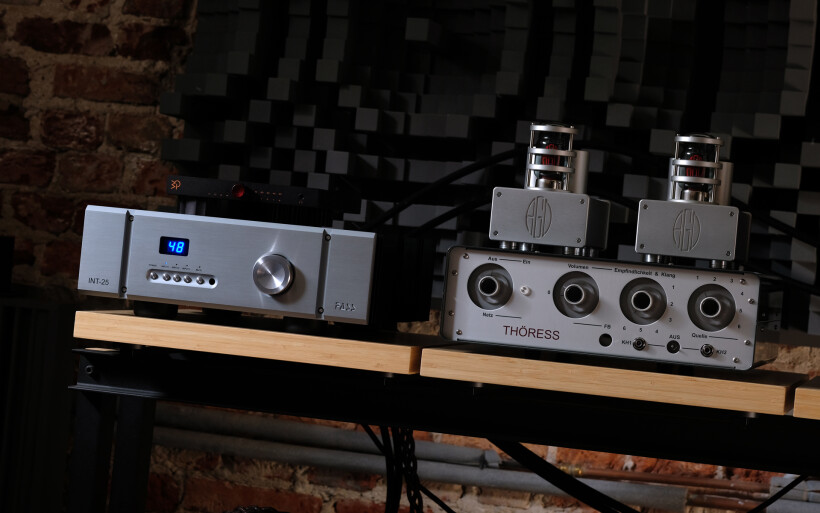 To double-check my findings, now AGD Production’s Audion monos fronted by the Thöress DFP preamp stepped in. Here my W11SE+ behaved still wilder, snappier and more powerful, hardly a surprise with quadruple the power. The sense of overall ease and responsiveness increased along with the DFP’s volume turned to the right. Voices grew substantially bigger which was this preamp’s well-known effect and so was its bass crack. This proved me once more how thunderous the DFP truly is. Virtual outlines grew optically bolder which made the DFP/Audion set a bit flamboyant and spicy. However, the Pass wasn’t spatially humbled. Its frames of all musical shapes slimmed a bit and preserved their humane postures. In that sense the INT-25 aimed at accuracy. To many ears such view would be, for lack of a better word, correct. To me it was simply different though no less valid. Most importantly, on imaging the Pass didn’t strike me as too distant, unclear or inferior in any way. It simply had its own plan on how to organize a soundstage, which was executed as meticulous as all else. Now’s the time to mention how each time the Pass was engaged, it provided a sensen of uniformity and correctness regardless of musical genre. It always sounded just right and this along with richness and malleability formed its sophisticated backbone.
To double-check my findings, now AGD Production’s Audion monos fronted by the Thöress DFP preamp stepped in. Here my W11SE+ behaved still wilder, snappier and more powerful, hardly a surprise with quadruple the power. The sense of overall ease and responsiveness increased along with the DFP’s volume turned to the right. Voices grew substantially bigger which was this preamp’s well-known effect and so was its bass crack. This proved me once more how thunderous the DFP truly is. Virtual outlines grew optically bolder which made the DFP/Audion set a bit flamboyant and spicy. However, the Pass wasn’t spatially humbled. Its frames of all musical shapes slimmed a bit and preserved their humane postures. In that sense the INT-25 aimed at accuracy. To many ears such view would be, for lack of a better word, correct. To me it was simply different though no less valid. Most importantly, on imaging the Pass didn’t strike me as too distant, unclear or inferior in any way. It simply had its own plan on how to organize a soundstage, which was executed as meticulous as all else. Now’s the time to mention how each time the Pass was engaged, it provided a sensen of uniformity and correctness regardless of musical genre. It always sounded just right and this along with richness and malleability formed its sophisticated backbone.
Summary
Modern integrated amps often arrive as compact packages that output hundreds of watts and provide D/A circuits, phono stages, headfi outs, network ends etc. If listed specs and functional extenders are essential for you, today’s Pass doesn’t fit the profile. Nonetheless, many such products would like to sound like it and I’m not aware of any that could.
Just as any other Pass Labs product, their INT-25 puts sound quality just next to practicality and robust tank-alike appeal, by my standards very much timeless in its form. This beast of an amp isn’t common but elegantly simple, built to last a lifetime and all in all very serious. By design it renders anything above its basic display, I/O and minimalist utilitarian exterior as excess. At camp Pass everything that’s not absolutely critical in fact is. If that’s the price for the INT-25 to excel at the core job, given its brilliant performance I call it a bargain.
Pass Labs INT-25 did wonderfully with speakers I had available at my place. Its class A charm augmented via detail retrieval, bass might and flex revealed very high fully adult sonic tier, as sensual, engaging and expressive as it was stout and insightful. This sort of artfully seasoned aroma requires top level engineering know-how and utmost capable ears, whereas Wayne Colburn and Nelson Pass are the two individuals you might want to google.
If 25/50wpc into 8/4Ω loads is plenty for you, then Pass Labs INT-25 surely deserves your attention and its highly realistic coin for what it truly is. Considering this killer amp being the smallest in the roster, it’s thrilling just to think about what its beefier more powerful stablemates are capable of. ‘Til next time!
Associated Equipment:
- Amplifier: AGD Productions Audion, Bakoon AMP-13R
- DAC: LampizatOr Pacific (KR Audio T-100 / Living Voice 300B + KR Audio 5U4G Ltd. Ed.)
- Speakers: Boenicke Audio W11 SE+, sound|kaos Vox 3afw
- Transport: fidata HFAS1-S10U
- Preamplifier: Thöress DFP
- Speaker cables: Boenicke Audio S3, LessLoss C-MARC
- Speaker signal conditioning: LessLoss Firewall for Loudspeakers
- Interconnects: Boenicke Audio IC3 CG
- Power components: Gigawatt PC-3 SE EVO+, Gigawatt PF-2 + Gigawatt LC-2 MK2 + Audiomica Laboratory Ness Excellence/LessLoss C-MARC
- USB components: iFi audio iGalvanic3.0, iFi audio micro iUSB3.0, 3x iFi audio Mercury3.0, iPower 9V
- Rack: Franc Audio Accesories Wood Block Rack
- Network: Fidelizer EtherStream, Linksys WRT160N
- Music: NativeDSD, Roon
Retail prices of reviewed components in EU (excl. tax):
- Pass Labs INT-25: $7’250
Manufacturer: Pass Labs





















































